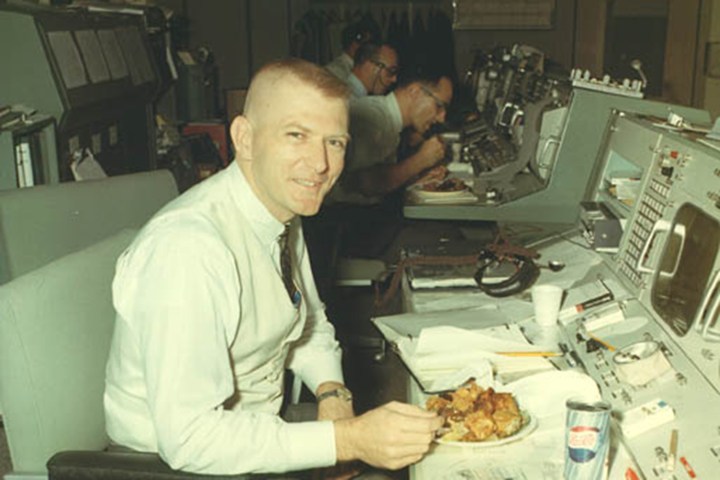
The most famous words ever uttered by Eugene Francis Kranz were never, in fact, said by him at all. At least, not exactly. In reality, the words “Failure is not an option” were spoken by the actor Ed Harris when he played Gene Kranz in the 1995 movie Apollo 13.
Fifty years ago, Kranz, the iconic NASA flight director for the Gemini and Apollo programs, was in Mission Control during the almost-doomed 13th Apollo mission. When the spacecraft’s oxygen system failed, Kranz led a team of young, inexperienced engineers and scientists to successfully return the crew to Earth: An achievement he was awarded the Presidential Medal of Freedom for carrying out.
Now aged 86, the NASA veteran and undisputed space hero spoke with Digital Trends about Apollo 13 and the state of space exploration today.
Digital Trends: By the time Apollo 13 took place, there had already been two successful lunar landings. At that point, did you feel confident that you had solved a lot of the early problems experienced on earlier space missions, whether that was a tragedy like Apollo 1 or just minor technical mishaps? How confident were you that this would be a success?

Gene Kranz: [In my previous career as a pilot], every time I climbed into an aircraft I got the hand salute from the crew chief saying that all was well. I never took off worried about what was going to happen. I always took off focused on the mission objectives. I was challenged by risk, rather than being afraid of risk. The greater the risk of the missions we flew, the greater the challenge. I had to be ready for it. With the Apollo 13 mission, I gave several interviews both before and one during the mission, where people asked me if we were going to get the crew back. I never doubted it. They thought I was an arrogant optimist.
DT: When did you first realize during the mission that something had gone seriously wrong?
It was at the last point in the mission where we could have saved them. We had the time to work the problem, we had the lunar module as a lifeboat, and were in a location on the trajectory where we could easily move to a path that would take us back to Earth. It was at a [juncture] in the mission where, even though we had a major problem, we had options out in front of us.
DT: How do you prepare for something like this?

I always prepared for each mission with a special key document called the mission rules. Mission rules provide preplanned decisions to manage the many risks during a mission. The development of the rules established a unified direction for the control team, astronauts, and program office. [They gave us] the best engineering and trajectory judgment to address mission risks. The mission rules for an average mission like the lunar missions ran around 300 pages, [equating to] more than 3,000.
That might sound a lot, but for every phase of the mission it works out at about 20 to 30 key rules that we apply to the decision-making process for each controller for the different mission periods. It means that, by the time a mission takes place, I’ve got everything that is normal or should happen in my mind — along with the options for what happens if something abnormal takes place. The mission planning, rules development, and training establish the relationship within the team and with the crew that whatever happens, they know we will get them home.
DT: What was your first meeting like with the Apollo 13 crew when they returned? I can’t even imagine what that must be like.

We didn’t get to see them until the controller and crew debriefings had been completed. Then he had a joint debriefing. The final debriefing was at Hofbraugarten in Dickinson, Texas, where we celebrated the successful completion of many months of work. The crews are aware of the risk. My teams are aware of the risk. Facing that risk– I won’t say it’s part of the thrill, but it’s something we mentally prepare for throughout the entire mission.
DT: Something that never ceases to amaze me is how young a lot of the mission controllers of those early space missions were. Am I right in thinking the average age of the person who put humankind on the moon was about 27?

At the time the Soviets launched Sputnik [in October 1957], the United States did not really have a generation of young people educated in science, technology, engineering, and mathematics. As soon as the Soviets demonstrated their ability in space, the United States — and, in particular, Senator Lyndon Johnson — realized that it was necessary to change the academic system within the United States to produce scientists and engineers. They established a student loan program in 1958 called the National Defense Education Act that provided opportunities for young people to go to college. It was very similar to what we had at the end of World War II for returning military members.
By the time the first group of students were graduating, it was 1962 and we were starting to fly the Mercury program who were experienced in the technologies of space. Many of them had been working in college laboratories with cryogenics, fuel cells, digital computers, and all those kinds of things. The older engineers who had worked on aircraft provided the leadership component. The space knowledge component came from these young people who had just graduated from college. It was an amazing enterprise that was absolutely wonderful to live and work in.
DT: During your career, you’ve sometimes expressed disappointment that support for space exploration dried up in the decades after the Apollo missions. Do you see things turning around today with the twin rise of both private space companies like SpaceX and President Trump’s proposal of another moon landing? How do you gauge the health of space exploration today?

The commercial entities that we’ve got today to explore space are doing great work. The greatest remaining challenge to exploration is the development of leaders with experience of making and accepting and living with risk-based decisions. Secondly, you need an industry that’s got broad capacity to do innovative work. When we were flying Apollo or Skylab or even Shuttle, we had a very broad-based aircraft industry in the United States sitting at the table and saying, ‘here’s one option’ or ‘here’s a different way of doing things.’ I think the greatest challenge is having enough diversity so you get different ideas put on the table.
DT: How about the proposed 2024 moon landing?
I talked to the American Senate last July, and what I said is that we really need to have clearly defined objectives, accompanied by resources. What we need is to have unity within the nation and within the industry to get the job done. We have to have a clearly defined focus or objective that we are pursuing. Leadership, unity, and focus are essential as we continue the business of space exploration.


